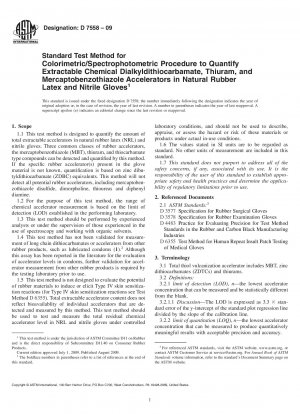ASTM D7558-09
Standard Test Method for Colorimetric/Spectrophotometric Procedure to Quantify Extractable Chemical Dialkyldithiocarbamate, Thiuram, and Mercaptobenzothiazole Accelerators in Natural Rubber Latex and Nitrile Gloves
- Standard No.
- ASTM D7558-09
- Release Date
- 2009
- Published By
- American Society for Testing and Materials (ASTM)
- Status
- Replace By
- ASTM D7558-09(2014)
- Latest
- ASTM D7558-09(2019)
- Scope
nbsp;nbsp;nbsp;Dialkyldithiocarbamates (DTCs), benzothiazoles, and thiurams are often used as vulcanization accelerators in NRL products. Zinc DTC accelerators are added either directly or are formed in situ during the vulcanization process via reaction between a thiuram(s) and zinc oxide. DTCs, benzothiazoles, and thiurams have been detected in leachates from medical devices made of rubber such as gloves. Studies have shown these chemicals can cause allergic contact dermatitis. A simple selective method to monitor rubber accelerator levels in rubber extracts would be useful for quality control, product screening and research.
This colorimetric assay measures dialkyldithiocarbamates, including zinc dialkyldithiocarbamates (ZDTC), mercaptobenzothiazole (MBT) and thiurams as a total thiol vulcanization accelerator level in rubber products. A UV spectrophotometer with detection at 320 nm is used to measure the ZDTC, mercaptobenzothiazole and thiurams. Sample extracts diluted at 1:20 prior to measurement on the spectrophotometer is usually sufficient to quantify the residual accelerator level from most commercially available rubber gloves; however, sample dilution can be adjusted (from neat extract to > 1:20 dilution) based on analytical needs. Thiurams and ZDTCs complex with cobalt turning the extract to a concentration-dependent shade of green. ZDTCs reacts quickly while thiurams react very slowly (requiring a heat catalyst). Mercaptobenzothiazole does not complex to Co(III), however, it absorbs strongly at 320 nm. It can be distinguished from both ZDTCs and thiurams by its strong absorbance at 320 nm without the cobalt dependent visible green color. Cobalt complexed thiurams and ZDTCs, but not MBT, also have and absorbance at 370 nm (2).
1.1 This test method is designed to quantify the amount of total extractable accelerators in natural rubber latex (NRL) and nitrile gloves. Three common classes of rubber accelerators, the mercaptobenzothiazole (MBT), thiuram, and thiocarbamate type compounds can be detected and quantified by this method. If the specific rubber accelerator(s) present in the glove material is not known, quantification is based on zinc dibutyldithiocarbamate (ZDBC) equivalents. This method will not detect all potential rubber accelerators, including mercaptobenzothiazole disulfide, dimorpholine, thioureas and diphenyl diamine.
1.2 For the purpose of this test method, the range of chemical accelerator measurement is based on the limit of detection (LOD) established in the performing laboratory.
1.3 This test method should be performed by experienced analysts or under the supervision of those experienced in the use of spectroscopy and working with organic solvents.
1.4 This test method has not been validated for measurement of long chain dithiocarbamates or accelerators from other rubber products, such as lubricated condoms (1). Although this assay has been reported in the literature for the evaluation of accelerator levels in condoms, further validation for accelerator measurement from other rubber products is required by the testing laboratory prior to use.
1.5 This test method is not designed to evaluate the potential of rubber materials to induce or elicit Type IV skin sensitization reactions (for Type IV skin sensitization reactions see Test Method D 6355
). Total extractable accelerator content does not reflect bioavailablity of individual accelerators that are detected and measured by this method. This test method should be used to test and measure the total residual chemical accelerator level in NRL and nitrile gloves under controlled laboratory conditions, and should not be used to describe, appraise, or assess the hazard or risk of these materials or products under actual in-use conditions.
ASTM D7558-09 Referenced Document
- ASTM D3577 Standard Specification for Rubber Surgical Gloves
- ASTM D3578 Standard Specification for Rubber Examination Gloves
- ASTM D4483 Standard Practice for Determining Precision for Test Method Standards in the Rubber and Carbon Black Industries
- ASTM D6355 Standard Test Method for Human Repeat Insult Patch Testing of Medical Gloves
ASTM D7558-09 history
- 2019 ASTM D7558-09(2019) Standard Test Method for Colorimetric/Spectrophotometric Procedure to Quantify Extractable Chemical Dialkyldithiocarbamate, Thiuram, and Mercaptobenzothiazole Accelerators in Natural Rubber Latex and
- 2009 ASTM D7558-09(2014) Standard Test Method for Colorimetric/Spectrophotometric Procedure to Quantify Extractable Chemical Dialkyldithiocarbamate, Thiuram, and Mercaptobenzothiazole Accelerators in Natural Rubber Latex and Nitrile Gloves
- 2009 ASTM D7558-09 Standard Test Method for Colorimetric/Spectrophotometric Procedure to Quantify Extractable Chemical Dialkyldithiocarbamate, Thiuram, and Mercaptobenzothiazole Accelerators in Natural Rubber Latex and Nitrile Gloves
